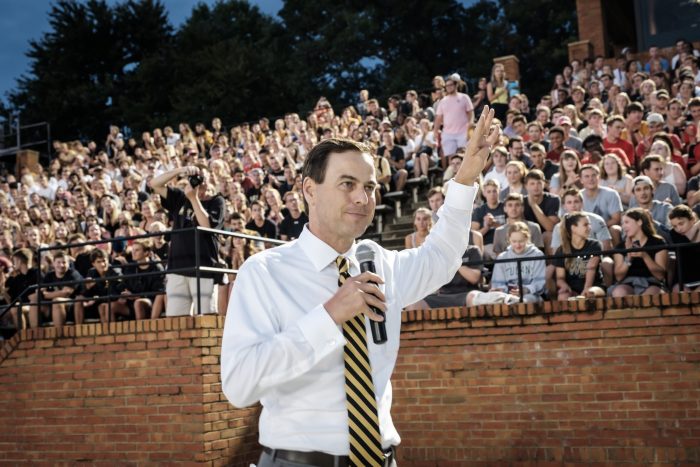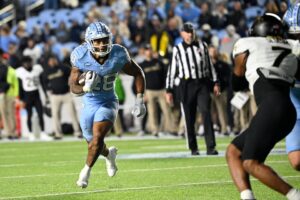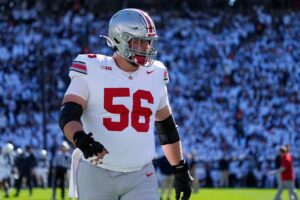It has been a pretty lofty year for college athletics in Winston-Salem, and thus a busy one for Wake Forest AD John Currie. From the success of the football team, to men’s basketball and a baseball team that arguably should have been in the post-season; the search for a new women’s basketball coach; and all of the usual work that goes into being an AD. He is in perpetual motion. So when we had our exclusive one-on-one with him this week there was a lot of ground to cover.
Last Word With Wake Forest AD John Currie
If you did not know John Currie but saw him on campus, it would not take much to figure out who he is and what he does. Currie wears one of those name badges you often see on people at evening fundraising events. It has his name and athletic director title right there. In the 90-degree heat of this day, he wears a simple white shirt. But the color of his tie loosely represents Wake Forest. Even the belt that adorned his khakis on this day had the Demon Deacon on it.
Go into his office and some of the first things you notice are the ceremonial shovel and hard hat from the groundbreaking ceremony for the McCreary Football Complex, the $38 million dollar project fully funded by donors under the supervision of Currie.
Football Driving The Bus
As with most FBS-level schools, football is the moving force throughout the athletic department. Last season’s 11-3 record was only the second time in program history the team hit the 10-win mark. The record, the ACC Atlantic Division title, and the win in the Gator Bowl paved the way for head coach Dave Clawson to get a contract extension. Because Wake is a private school, they can manage to keep the terms of the extension under wraps. But Currie told us the decision to reward Clawson was an easy one to make.
“It was a universal desire,” Currie said. “Dave wanted it. The president wanted it. The chairman of the board wanted it. I wanted it. So, we figured it out and it wasn’t hard.”
As obvious as it may have been, it cannot be overlooked that the lofty success of 2021 came in Clawson’s eighth year at the helm. That is significantly more patience shown by Wake Forest than what happens at many other programs across the country. Currie credits his predecessor Ron Wellman both with hiring Clawson and letting him have the time to put his imprint on the program. “Ron’s understanding of process and time and how a program is built was key.”
Currie and Clawson knew each other from their time at Tennessee. So Currie, who still confers with Wellman from time to time, was more than happy with whom he inherited to run the football program. “We hired the right coach.” And as for the patience shown to get to the 11-3? “It doesn’t seem like that big of a leap of faith to me,” Currie said. “It was logical.” He said Clawson has, “Created a culture that is complimentary to Wake Forest and vice versa. He runs to our strengths. He is very specific as to what fits and does not fit in attracting student-athletes who value what Wake Forest offers.” As if to underscore the need for patience, development, and process, Currie offered, “Sometimes the tree that grows the fastest is not the strongest tree.”
The Process Is The Thing
There is a theme that becomes apparent in talking to Currie. The process is just as important to him as the ultimate end. He often takes his time in answering questions as if putting the question through a process in his head before responding.
Case in point; after a timely pause, Currie rejected the notion that more patience was shown with Clawson because Wake Forest doesn’t have the same expectations as some of the college football blue bloods. “The only discomfort in that question is to imply that we think losing is ok. I think our history teaches us to appreciate success and to recognize that quick fixes don’t produce sustainable success.”
He watches programs across the country that have varying interpretations of success. He says many are quick to hit the change button. “Every time you make a change, it’s destabilizing. You have to start over.”
While Currie does not accept that the expectations at Wake may be lower, he does acknowledge they are different. He pointed out that for all the tens of millions of dollars Wake Forest has invested in the football program, the Demon Deacons are not trying to compete in an untenable financial arms race. They don’t have to fill a massive football stadium every Saturday. He goes through the mental process of envisioning the cathedral size stadiums. “At a place that built their financial model on having 80,000 seats filled, and then all of a sudden, they’ve got 60,000 seats filled. That becomes a problem. Momentum, or a lack thereof, can be demoralizing, destabilizing, and destructive in a program,” he said.
Protecting Games In The Midst Of Change
Certainly, in the larger picture, Wake, and the ACC as a whole is under regular scrutiny for their own process. Conference commissioner Jim Phillips was one of the first to talk about abandoning division play within the conference so as to allow the two teams with the best records to go to the conference title game. Yet, while the thought process continues at the executive level, two other conferences, the Pac-12, and the Mountain West, did so swiftly and decisively. To Currie, unsurprisingly, the process matters as much as the end result.
“I’m for whatever continues to strengthen our conference,” he said. “You have to be careful if you are trying to manipulate to an outcome.” He said instead of trying to ensure that two marquee names are in the championship game every year, “Let’s make sure we’re thinking about what the process was to get to that. If you focus so much on the ending point, you might miss something along the way.”
Currie favors a system that will protect the rivalry games like Wake versus NC State, a match-up played consecutively every year since 1910. It is the longest continuous rivalry between 2 ACC schools and is the second-longest streak in the nation. As he put it, he wants the established rivalries, plus, “varieties” for the fans. That would generally be found in a 3-5-4 format. It would have three annual rivalry games locked in, five conference games that rotate opponents year to year, and the four out-of-conference games that come with an eight-game conference schedule.
Currie said the loss of some annual rivalry games throughout the conference was a “Certain casualty or unintended consequence of conference realignment.” In other words, it was the process.
The Playoffs
Any redoing of conference play in all leagues is done so with an eye on how it impacts the college football playoffs and likely expansion. For the ACC, the picture is muddled by a reputation for being a top-heavy conference. Clemson has been carrying the banner for the ACC for more than a handful of years in terms of playoff potential. But the Tigers finished third in the Atlantic Division last season and have a lot of holes to fill this year. So, does the ACC need a Clemson resurgence for national respect? Currie isn’t buying it. “We’ve got great programs. We just don’t have the great 60-year brand names,” he said. “We’ve got to go win the games. We have to beat the teams we’re supposed to beat. If we don’t beat VMI, we’ll be letting down the whole league.”
Currie is a believer in playoff expansion…depending upon how you get there. “I like the idea of having more access to the post-season for more teams,” he said. Of course, the concern is the process of getting there. What he wants to see is, “How we do that in the context of the impact on athlete academic load, the impact on student-athlete’s safety and welfare.”
There are also historical concerns. Currie wants to save as many of the bowl games as possible. He said the experience afforded the players, plus the positive financial impact on the schools has to be considered. “I think we need to be thoughtful of the why” when debating playoff expansion. He said he believes Phillips is right in hitting the pause button on what seemed like inevitable playoff expansion this time last year. “I do believe Commissioner Phillips was right on the money that this might be the right decision to make, but given a number of other things, is it the right time to make that decision?”
Revolving Doors
Once you get that Currie focuses heavily on the process, it should come as no surprise where he is with regards to all the shifting of schools from one conference to another. The moving of Oklahoma and Texas to a future spot in the SEC caused a ripple effect of teams leaving other conferences to fill the voids in the Big XII, and then other schools filling gaps in the AAC and other conferences. It creates an inevitable conversation about the possibility of just a couple of super conferences down the road.
Currie says the market determines what it needs to survive. “We’ve been talking about that [super conferences] my entire career, 28 years, regarding conference realignments and stuff,” he said. “The market finds a solution. There’s not any evidence currently that the big aggregation is solving the evident problems.”
NIL is an obvious, and restricted topic, for any AD because of limits on how schools can be involved. The cost of a Wake Forest education runs nearly $60,000 per year. Add in cost-of-living expenses and other needs and it climbs to more than $80,000. Currie says the school also spends about $15,000 per student-athlete per year on things like sports medicine, nutrition, and academic services.
The NIL Gorilla In The Room
He said he believes the student-athletes are getting justifiable rewards with their scholarships. But he does favor them being able to own the rights to monetize their name, image, and likeness. It is the expanding of a value of a scholarship as he sees it. He cited the case of former Wake golfer Emilia Migliaccio about three years ago. She wrote a book and in the forward of the book identified herself as a Wake Forest golfer. The NCAA prevented her from selling the book under its rules at the time. “It didn’t make any sense,” Currie said.
Of course, he does have questions as to what NIL started as and what it has become with Collectives. The concern is the process. “I believe that there is a right way to make sure that these things are applicated in a constructive way.”
The constructive way, for Currie, does not include pay-for-play. While the NCAA theoretically does not allow for it, schools via collectives are doing it. NIL was intended to have specific deliverables from the athlete in exchange for the financial agreement with the marketer. But with Alston v. NCAA removing any caps on athlete compensation, the Collectives jumped in. They provided financial arrangements that in some cases simply required the athlete to suit up and play.
Currie called that model, “Unsustainable.” He added, “Ultimately it will create unintended consequences. What happens when a booster collective is providing money for a particular player through some kind of deal and that player doesn’t play?”
For Currie, taking time to understand and work through the process will generally get the more desired results.
[Main Image Courtesy Wake Forest Athletics]






